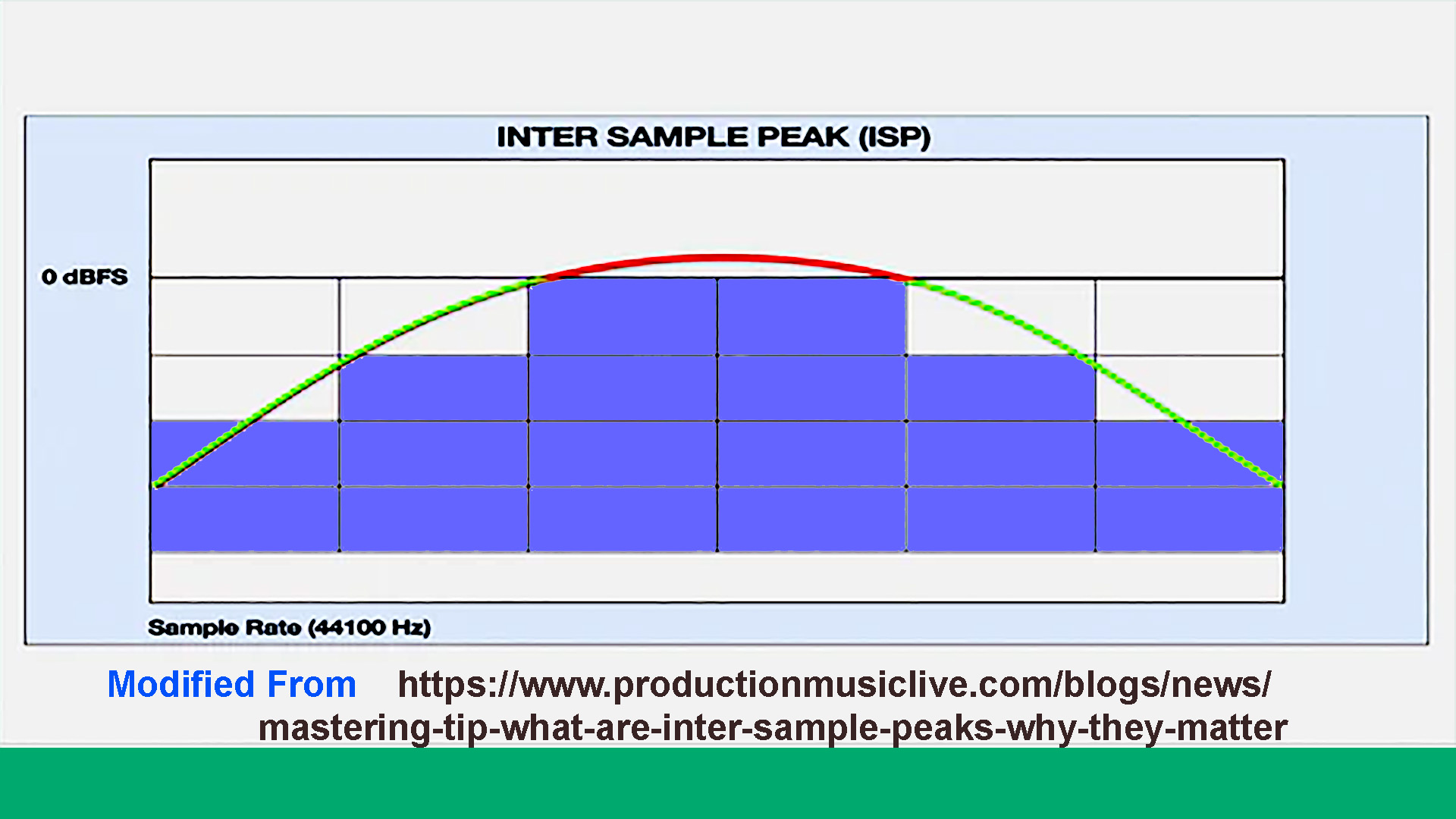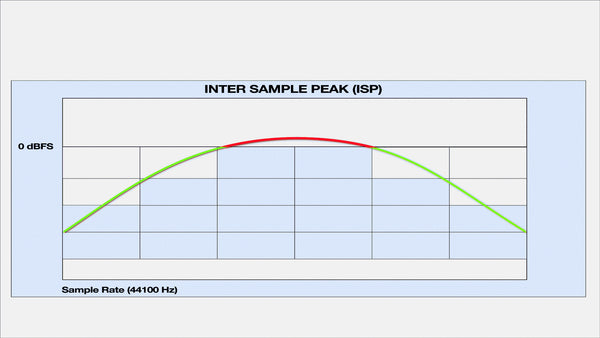Inter-sample peaks are brief spikes in audio that occur when converting audio from digital to analog. They can cause distortion in audio playback and must be managed carefully.
Mastering audio is an essential aspect of music production. By refining and enhancing the sound quality of audio recordings, a mastering engineer can create a more polished and professional final product. However, one of the challenges of mastering is managing inter-sample peaks.
These brief spikes in audio occur when converting digital audio to analog, causing distortion in playback. We will explore what inter-sample peaks are, why they matter, and how to prevent them from ruining your audio.
Inter Sample Peaks: What Are They?
Inter sample peaks occur when the peak of a digital audio waveform goes above 0dBFS. This can lead to distortion and affect the overall sound quality. Understanding inter sample peaks can improve the mastering process and result in a cleaner sound.
Definition Of Inter Sample Peaks
Inter Sample Peaks (ISPs) refer to the peak values that exceed the maximum threshold of a digital audio signal during the conversion process. In simpler terms, ISPs are the brief spikes in amplitude that occur when analog audio signals are converted to digital signals. ISPs occur cyclically and can cause distortion in audio playback as well as damage to amplifiers and speakers.
Causes Of Inter Sample Peaks
There are various causes of ISPs which include, but are not limited to:
- The presence of transient peaks in the audio signal
- Inadequate headroom during mixing and mastering
- Improper use of digital signal processing (DSP) tools
- Bit-depth and sample rate conversion
These causes all lead to issues of digital audio clipping which can be minimized by employing proper gain staging, utilizing high-quality DSP plugins, and carefully monitoring the digital signal levels.
The Effects Of Inter Sample Peaks
ISPs can have a detrimental effect on your audio signals, leading to reduced sound quality and, in some cases, permanent damage to your audio equipment. ISP can cause a reduction in dynamic range and can result in unwanted distortion that affects the clarity and volume of your audio. Furthermore, the effects of ISP show up most when the track is subjected to MP3 or AAC compression, leading to a poor listening experience for your audience. Therefore, it is important to understand and implement strategies to avoid ISPs to achieve optimum audio quality.

Credit: hometheaterhifi.com
Why Do Inter Sample Peaks Matter?
Inter sample peaks (ISP) refer to the distortion that occurs when converting an analog signal to digital audio. ISPs matter because they can cause audio clipping and reduce the overall quality of the audio. Mastering engineers need to be aware of ISPs to avoid these issues and produce high-quality audio.
Inter-sample peaks are a common issue that can affect the quality of audio recordings. They occur when the level of a digital signal exceeds 0 dBFS, the maximum level that can be accurately represented in a digital audio system. Because of this, inter-sample peaks can lead to distortion and affect the overall quality of a recording.
Implications For Audio Quality
Inter-sample peaks can result in distortion, which can significantly reduce the audio quality. This issue can be particularly noticeable when the sound is played back on a digital audio player or system that has a different implementation of the digital-to-analog converter (DAC) than the one used during mixing and mastering. For audiophiles, this can be an unwelcome experience as the sound quality falls significantly with digital distortion.
Impact On Audio Processing
Inter-sample peaks can also make it difficult to apply certain types of audio processing, such as compression and limiting, during mixing and mastering. These processes can increase the overall level of the audio signal, potentially pushing it beyond 0 dBFS and causing inter-sample peaks. Alternatively, reducing signal levels can mean pushing up noise level, leading to another problem of increases in the noise level.
Why Mixing And Mastering Engineers Need To Be Aware Of Them
Given the potential impact on audio quality and processing, it’s essential for mixing and mastering engineers to be aware of inter-sample peaks. They need to ensure that the audio signal remains below 0 dBFS and the inter-sample peaks are in check by applying the proper signal level reduction or limiting when required. They have to make sure that no other processing tools are causing issues which can lead to digital distortion. In conclusion, inter-sample peaks are an issue that can significantly reduce the quality of digital audio. Mixing and mastering engineers need to be aware of this so they can take the necessary steps to minimize their occurrence. Staying vigilant about the correct techniques, tools, and configurations will lead to a high audio quality mix and master output.
How To Deal With Inter Sample Peaks
Inter sample peaks are sudden voltage spikes that occur at the interval between digital audio samples. These peaks can result in distortion or clipping, causing significant degradation in the quality of audio. As a mastering tip, it is vital to address inter-sample peaks to ensure a high-quality output.
Inter sample peaks are a common issue in audio recording and mastering that can cause distortion and clipping. Fortunately, there are various ways to deal with these peaks, from identifying them during recording and mixing to fixing them during mastering. Here are some tips on how to deal with inter sample peaks effectively.
Identifying Inter Sample Peaks
The first step in dealing with inter sample peaks is to identify them. Inter sample peaks occur when the waveform of an audio signal goes above 0dBFS (full scale) between samples, causing digital distortion. One way to identify inter sample peaks is to use a specialized metering plugin that can detect these peaks, such as the Waves L3-LL UltraMaximizer.
Preventing Inter Sample Peaks During Recording And Mixing
Preventing inter sample peaks is the best way to deal with them. When recording, it’s essential to keep levels below 0dBFS to avoid clipping and distortion. It’s also crucial to leave enough headroom to allow for mastering later on. During mixing, it’s advisable to use a limiter on the master bus to keep levels in check and avoid inter sample peaks.
Fixing Inter Sample Peaks During Mastering
If inter sample peaks are still present during mastering, there are several ways to fix them. One approach is to use a brickwall limiter, which controls the peaks by reducing the volume of the entire mix. Another technique is to use a clipper, which clips the waveform to avoid inter sample peaks. It’s worth noting that brickwall limiting and clipping can affect the dynamics and overall sound of the mix, so it’s essential to use these tools sparingly and carefully. In conclusion, inter sample peaks are a common issue in audio recording and mastering, but they can be dealt with effectively by identifying them, preventing them during recording and mixing, and fixing them during mastering. By following these tips, you can ensure that your audio recordings and mastered tracks sound clear, crisp, and distortion-free.
Tools And Techniques For Avoiding Inter Sample Peaks
Inter sample peaks are brief peaks in the audio signal that can cause distortion, affecting the quality of the final mix or master. To avoid these peaks, tools such as limiting and clipping can be used, while techniques such as gain staging and volume automation can help prevent them from occurring in the first place.
If you are in the audio production industry, you would have come across inter sample peaks, and you should know how to avoid them. Inter sample peaks happen when the peak amplitude exceeds the maximum limit resulting in distorted audio. However, you can avoid inter sample peaks using the following tools and techniques:
Limiters
Limiters are essential in preventing inter sample peaks. They work by analyzing the input audio signal and restricting the output signal from exceeding the maximum threshold level. Therefore, the limiter acts as a safeguard against distortion and helps you maintain a consistent sound level. It is advisable to use it at the end of your signal chain.
Clippers
Clippers work by preventing the audio signal from going over the maximum level limit. Once the signal level is higher than the limit, a clipper cuts off the waveform’s top portion, which results in transient distortion. They are efficient in preventing inter sample peaks when the input signal is unpredictable and fluctuates beyond the safe range.
Brickwall Filters
Brickwall filters are another way to avoid inter sample peaks. They are designed to remove peaks beyond a specific threshold level while maintaining the audio’s original sound and quality. The filter acts as a gatekeeper, letting desired frequency pass while blocking unwanted signals. It is advisable to use the brickwall filter before other processing tools to avoid overload and distortion. In conclusion, inter sample peaks could negatively impact the sound quality of your audio. Therefore, it is essential to avoid them at all costs. The tools and techniques mentioned above are effective ways of preventing inter sample peaks. By applying these techniques, you can improve the sound quality of your audio and keep it distortion-free.
Best Practices For Mastering Audio With Inter Sample Peaks
Mastering audio with inter-sample peaks is essential for achieving a clean and polished sound. Inter-sample peaks occur when the sample rate is exceeded, causing distortion and unwanted artifacts. By understanding these peaks and utilizing best practices, audio engineers can create high-quality recordings that sound great on any device.
Mastering is an important aspect of music production that can make or break the final sound quality of a track. Many mastering engineers have encountered inter-sample peaks- a phenomenon that can cause distortion in the final mix. Inter-sample peaks occur when digital audio devices produce a signal that exceeds the maximum amplitude that can be resolved by a digital-to-analog converter.
Balancing Attenuation And Preservation Of Dynamics
The key to managing inter-sample peaks in mastering is to strike a balance between attenuation and the preservation of dynamics. Attenuation involves lowering the peak volume of the audio signal while preserving dynamics refers to retaining the natural dynamics of the track. A delicate balance must be achieved to prevent clipping or distortion from inter-sample peaks.
Measuring Inter Sample Peaks Using Lufs
Measuring inter-sample peaks can help determine if they are present in your track. Loudness Units Full Scale (LUFS) is a measure of perceived loudness that considers the entire length of the track. The human ear cannot detect inter-sample peaks that last for a few samples, so using LUFS is a better way to measure the perceived loudness of the track.
Fine-tuning Mastering Techniques To Address Inter Sample Peaks
To fine-tune mastering techniques to address inter-sample peaks, use tools like limiters and compressors. The limiter can raise the quiet parts of the mix while maintaining the loudness, preventing inter-sample peaks. Compressors can be used to control the dynamic range of the mix, making it easier to attenuate the parts that contain inter-sample peaks. In conclusion, mastering audio with inter-sample peaks can be challenging, but with the right tools and techniques, it can be remedied. By balancing attenuation and preservation of dynamics, measuring inter-sample peaks using LUFS, and fine-tuning mastering techniques; any inter-sample peaks in your track can be prevented.

Credit: www.productionmusiclive.com

Credit: www.productionmusiclive.com
Frequently Asked Questions On Mastering Tip What Are Inter Sample Peaks Why They Matter
How Do You Avoid Intersample Peaks?
Avoid intersample peaks by keeping your levels below 0 dBFS, using a high-quality limiter, and avoiding excessive EQ boosts. Use dithering when converting to lower-resolution formats and avoid extreme compression.
What Is The Best True Peak Level For Mastering?
The best true peak level for mastering typically lies between -1 dBTP and -0. 5 dBTP. However, it largely depends on the genre of music and the preferences of the producer or mastering engineer. It’s important to avoid going above 0 dBTP to prevent distortion and preserve the quality of the audio.
What Is The Difference Between Peak And True Peak?
Peak is the highest signal level reached in an audio recording, while true peak is the highest waveform peak that results from the conversion from digital to analog. True peak values are crucial for ensuring that a recording will not experience any clipping or distortion when played back on different devices.
What Is Isp On A Limiter?
ISP on a limiter refers to the Internet Service Provider (ISP) limiting the bandwidth of a user’s internet connection. The ISP can slow down the speed of the internet connection for users who have exceeded their data limit or during peak hours to ensure equal sharing of network resources.
Conclusion
Understanding inter-sample peaks is essential to produce high-quality audio. Mastering engineers need to be aware of the potential issues that may arise from them and how to avoid them. Proper gain staging and limiting techniques can significantly reduce the risk of inter-sample peaks.
By keeping inter-sample peaks in check, you can create audio that meets industry standards and sounds great on any playback system. So, pay attention to inter-sample peaks, and take your mastering skills to the next level.